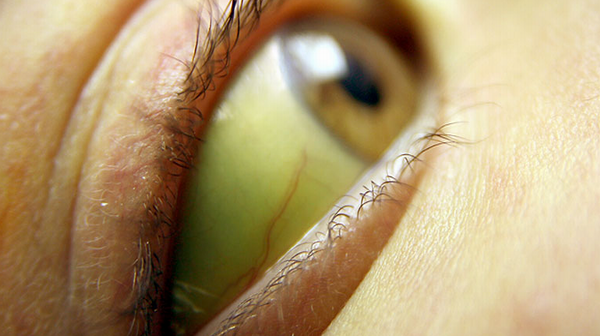What's in this article?
Hepatitis Overview
 Hepatitis is a medical condition defined by the inflammation of the liver and characterized by the presence of inflammatory cells in the tissue of the organ. Hepatitis may occur with limited or no symptoms, but often leads to yellow discoloration of the skin, mucus membranes, and conjunctivae, poor appetite and malaise. Hepatitis is acute when it lasts less than six months and chronic when it persists longer. The condition can be self-limiting (healing on its own) or can progress to fibrosis (scarring) and cirrhosis.
Hepatitis is a medical condition defined by the inflammation of the liver and characterized by the presence of inflammatory cells in the tissue of the organ. Hepatitis may occur with limited or no symptoms, but often leads to yellow discoloration of the skin, mucus membranes, and conjunctivae, poor appetite and malaise. Hepatitis is acute when it lasts less than six months and chronic when it persists longer. The condition can be self-limiting (healing on its own) or can progress to fibrosis (scarring) and cirrhosis.
Types of hepatitis
There are five main types of hepatitis that are caused by a virus, A, B, C, D, and E – plus types X and G.
Hepatitis A
This is caused by eating infected food or water. The food or water is infected with a virus called HAV (hepatitis A virus). Anal-oral contact during sex can also be a cause. Nearly everyone who develops Hepatitis A makes a full recovery – it does not lead to chronic disease.
Hepatitis B
This is an STD (sexually transmitted disease). It is caused by the virus HBV (hepatitis B virus) and is spread by contact with infected blood, semen, and some other body fluids.
Hepatitis C
Hepatitis C is usually spread through direct contact with the blood of a person who has the disease. It is caused by the virus HCV (hepatitis C Virus). The liver can swell and become damaged. In hepatitis C, unlike hepatitis B, liver cancer risk is only increased in people with cirrhosis and only 20% of hep C patients get cirrhosis. Feces is never a route of transmission in hepatitis C. Donated blood is also tested for hepatitis C.
Hepatitis D
Only a person who is already infected with hepatitis B can become infected with hepatitis D. It is caused by the virus HDV (Hepatitis D Virus). Infection is through contact with infected blood, unprotected sex, and perforation of the skin with infected needles. The liver of a person with Hepatitis D swells.
Hepatitis E
A person can become infected by drinking water that contains HEV (hepatitis E virus). The liver swells but there is no long-term consequence. Infection is also possible through anal-oral sex.
Hepatitis X
If a hepatitis cannot be attributed to the viruses of hepatitis A, B, C, D, or E, it is called hepatitis X. In other words, hepatitis of an unknown virus.
Hepatitis G
This is a type of hepatitis caused by the hepatitis G virus (HGV). Usually there are no symptoms. When there are symptoms, they are very mild.
Signs and symptoms
Signs and symptoms Many people with hepatitis experience either mild symptoms or none at all. Remember that an infected person’s feces are always infectious to other people. When symptoms appear, they usually do so about 15 to 180 days after the person has become infected.
The acute phase of hepatitis symptoms
The initial phase of hepatitis is called the acute phase. The symptoms are like a mild flu, and may include:
♦ Diarrhea
♦ Fatigue
♦ Loss of appetite
♦ Mild fever
♦ Muscle or joint aches
♦ Nausea
♦ Slight abdominal pain
♦ Vomiting
♦ Weight loss.
The acute phase is not usually dangerous, unless it develops into the fulminant or rapidly progressing form, which can lead to death.
Hepatitis Treatment
♦ Bed rest, abstaining from alcohol, and taking medication to help relieve symptoms. Most people who have hepatitis A and E get well on their own after a few weeks.
♦ Hepatitis B is treated with drugs, such as lamivudine and adefovir dipivoxil. Hepatitis C is treated with a combination of peginterferon and ribovarin.
♦ Liver transplant of hepatitis B or C, or D-caused liver failure.





